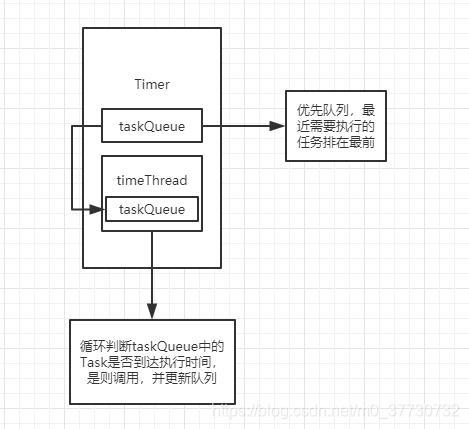版权声明:本文为博主原创文章,未经博主允许不得转载。 https://blog.csdn.net/m0_37730732/article/details/88046425
一、类结构图

二、源码
2.1 Timer中的成员变量,可见其中有TaskQueue、TimerThread。TaskQueue用于存储每次schedule的Task,它是一个优先队列,最近执行的Task会排在队头。而TimerThread是一个线程,它负责判断TaskQueue中的task周期是否到达,并调用它。
/**
* The timer task queue. This data structure is shared with the timer
* thread. The timer produces tasks, via its various schedule calls,
* and the timer thread consumes, executing timer tasks as appropriate,
* and removing them from the queue when they're obsolete.
*/
private final TaskQueue queue = new TaskQueue();
/**
* The timer thread.
*/
private final TimerThread thread = new TimerThread(queue);
/**
* This object causes the timer's task execution thread to exit
* gracefully when there are no live references to the Timer object and no
* tasks in the timer queue. It is used in preference to a finalizer on
* Timer as such a finalizer would be susceptible to a subclass's
* finalizer forgetting to call it.
*/
private final Object threadReaper = new Object() {
@SuppressWarnings("deprecation")
protected void finalize() throws Throwable {
synchronized(queue) {
thread.newTasksMayBeScheduled = false;
queue.notify(); // In case queue is empty.
}
}
};
2.2 在Timer实例化后TimerThread会开始执行
/**
* Creates a new timer whose associated thread has the specified name,
* and may be specified to
* {@linkplain Thread#setDaemon run as a daemon}.
*
* @param name the name of the associated thread
* @param isDaemon true if the associated thread should run as a daemon
* @throws NullPointerException if {@code name} is null
* @since 1.5
*/
public Timer(String name, boolean isDaemon) {
thread.setName(name);
thread.setDaemon(isDaemon);
thread.start();
}
2.3 下面分析一下TimerThread的run方法,run调用了mainLoop。
如果taskQueue为空或者Task运行异常,则TimerThread去wait等待。否则取出taskQueue中的第一个任务(优先队列,第一个任务即为最近要执行的任务),循环判断是否到达了执行时间,是则执行,然后更新优先队列。
public void run() {
try {
mainLoop();
} finally {
// Someone killed this Thread, behave as if Timer cancelled
synchronized(queue) {
newTasksMayBeScheduled = false;
queue.clear(); // Eliminate obsolete references
}
}
}
/**
* The main timer loop. (See class comment.)
*/
private void mainLoop() {
while (true) {
try {
TimerTask task;
boolean taskFired;
synchronized(queue) {
// Wait for queue to become non-empty
while (queue.isEmpty() && newTasksMayBeScheduled)
queue.wait();
if (queue.isEmpty())
break; // Queue is empty and will forever remain; die
// Queue nonempty; look at first evt and do the right thing
long currentTime, executionTime;
task = queue.getMin();
synchronized(task.lock) {
if (task.state == TimerTask.CANCELLED) {
queue.removeMin();
continue; // No action required, poll queue again
}
currentTime = System.currentTimeMillis();
executionTime = task.nextExecutionTime;
if (taskFired = (executionTime<=currentTime)) {
if (task.period == 0) { // Non-repeating, remove
queue.removeMin();
task.state = TimerTask.EXECUTED;
} else { // Repeating task, reschedule
queue.rescheduleMin(
task.period<0 ? currentTime - task.period
: executionTime + task.period);
}
}
}
if (!taskFired) // Task hasn't yet fired; wait
queue.wait(executionTime - currentTime);
}
if (taskFired) // Task fired; run it, holding no locks
task.run();
} catch(InterruptedException e) {
}
}
}
2.4 调用Timer.schedule添加任务时,最终会调用 sched(TimerTask task, long time, long period),它会设置任务周期并添加到queue中
/**
* Schedule the specified timer task for execution at the specified
* time with the specified period, in milliseconds. If period is
* positive, the task is scheduled for repeated execution; if period is
* zero, the task is scheduled for one-time execution. Time is specified
* in Date.getTime() format. This method checks timer state, task state,
* and initial execution time, but not period.
*
* @throws IllegalArgumentException if {@code time} is negative.
* @throws IllegalStateException if task was already scheduled or
* cancelled, timer was cancelled, or timer thread terminated.
* @throws NullPointerException if {@code task} is null
*/
private void sched(TimerTask task, long time, long period) {
if (time < 0)
throw new IllegalArgumentException("Illegal execution time.");
// Constrain value of period sufficiently to prevent numeric
// overflow while still being effectively infinitely large.
if (Math.abs(period) > (Long.MAX_VALUE >> 1))
period >>= 1;
synchronized(queue) {
if (!thread.newTasksMayBeScheduled)
throw new IllegalStateException("Timer already cancelled.");
synchronized(task.lock) {
if (task.state != TimerTask.VIRGIN)
throw new IllegalStateException(
"Task already scheduled or cancelled");
task.nextExecutionTime = time;
task.period = period;
task.state = TimerTask.SCHEDULED;
}
queue.add(task);
if (queue.getMin() == task)
queue.notify();
}
}
2.5 取消任务
public void cancel() {
synchronized(queue) {
thread.newTasksMayBeScheduled = false;
queue.clear();
queue.notify(); // In case queue was already empty.
}
}